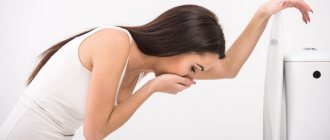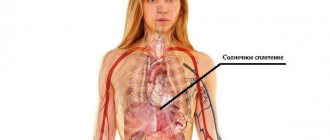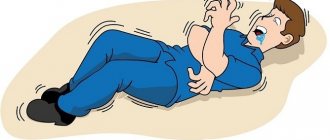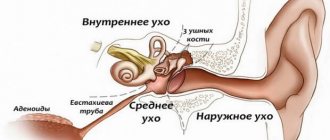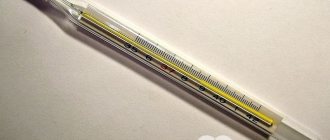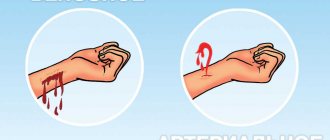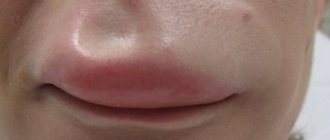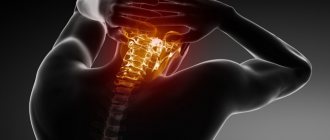Sunstroke is a consequence of prolonged exposure of the uncovered head to direct rays of the sun.
The body receives an excessive dose of heat and ultraviolet radiation without having time to cope with heat transfer. This provokes negative consequences.
When overheated, sweating is disrupted, the normal rhythm of blood circulation is disrupted, the concentration of free radicals in tissues and cells increases, causing intoxication of the body, and the general condition worsens.
Sunstroke is especially dangerous for people with heart disease; blood pressure can rise to the point of hypertensive crisis, and cardiac arrest can occur.
Next, we will look at the symptoms and treatment for sunstroke, and tell you how to provide first aid for sunstroke.
Symptoms of sunstroke
If sunstroke occurs, mild symptoms are as follows:
- thirst;
- unbearable weakness;
- headache with nausea, vomiting;
- rapid breathing and rapid pulse;
- dilated pupils.
Help at this stage is to provide coolness and move it to the shade. Place the patient in a position so that he cannot choke on vomit.
The average degree is characterized by the following features:
- sudden loss of strength, muscle weakness;
- congestion in the ears;
- an increase in headache causing vomiting and nausea;
- loss of confidence in movements, the appearance of dizziness;
- fainting;
- nosebleeds;
- tachycardia;
- high temperature, up to 40 degrees;
- with an uncertain gait.
The severe form comes on suddenly. The face first turns very red as a result of hyperemia, and then, on the contrary, turns pale and cyanosis appears near the lips.
Further, the signs increase - there is a change in consciousness, convulsions, coma, involuntary urination, hallucinations.
In rare cases, when there is no doctor nearby and first aid was not provided in a timely manner, death is possible.
Symptoms in children may include the following:
- unexpected irritability, tearfulness, hysterical behavior. Excessive sun greatly affects the child’s psyche, disrupting the normal state of the body. Take the baby out into an open sunny space for a maximum of 20 minutes, alternating the time with being in the shade.
- after the stage of overexcitation, a phase of lethargy begins, with the appearance of headaches and shortness of breath. Nausea and vomiting may occur.
- a sharp increase in temperature to the highest levels, up to 40. The pulse either quickens or, on the contrary, slows down. Hallucinations and delusions occur.
- the most dangerous moment is loss of consciousness. The skin becomes bluish, cool and moist to the touch, despite the high temperature. Cold sweat covers the entire body. This condition is dangerously fatal. If you faint, you should immediately run to the doctor or call an ambulance. If you are irritable, lethargic without fainting, you can try to cope with overheating on your own, but if you lose consciousness, you can’t.
External signs of heat stroke
Overheating occurs due to prolonged exposure to heat, high humidity or the sun. The problem develops gradually, the speed depends on many factors. Everyone needs to know how heat stroke manifests itself externally, because a person himself may not notice that overheating has begun. With it, the victims experience the following changes:
- local redness of the face and body, an unnatural blush appears;
- the skin becomes dry and too hot to the touch;
- the person is breathing heavily;
- in case of a moderate impact, a person’s coordination of movements is impaired;
- pupils dilate.
Causes and risk factors for sunstroke
The following patients are at risk of easily getting sunstroke.
- excess weight.
- prolonged exposure to stressful situations, increased emotionality;
- inappropriate clothing;
- alcohol intoxication and excessive smoking;
- presence of diseases of the cardiovascular system;
- presence of neurological diseases;
- children and elderly.
Children under three years of age are easily at risk of sunstroke. They have additional causes that cause hyperthermia. Of course, older children can overheat in the sun, but babies are a risk group. A child under one year old has not yet developed its own thermoregulation.
It is difficult for him to cope with high ambient temperatures, so you should not walk with your baby at 35 or above.
Sunstroke in infancy occurs from a lack of water in the body. Increased attention should be paid to overweight children who have excessive sweating (hyperhidrosis).
Children with nervous system problems are also overly sensitive to heat due to large fluid loss and the effect of direct sunlight on the central nervous system (CNS).
Elderly people are a separate risk group. They have a whole range of chronic diseases that respond differently to hyperthermia.
Exposure to the sun is especially dangerous for those with central nervous system problems - dyscirculatory encephalopathy, epilepsy. They have convulsions added to other symptoms of hyperthermia. Elderly people should immediately call a doctor, even if their condition improves.
To avoid getting hit, limit exposure to the sun to a maximum of 20 minutes a day, sunbathing is strictly prohibited, or choose a place under a tree, awning, or umbrella, where there is wind and coolness.
Sunstroke - first aid, signs, symptoms in adults and children
Sunstroke is the exposure of the body to a large amount of heat, which the body is unable to control and cannot neutralize. Not only sweating is disrupted, but also blood circulation (vessels dilate, and blood “stagnates” in the brain).
Many people mistakenly believe that heatstroke and sunstroke are the same thing. The development mechanism is, indeed, quite similar, but heat stroke can be caused by exposure to any heat, and solar stroke can be caused by heating the body under the sun. First aid for sunstroke is a skill that every person should master in order to help others and themselves, if necessary.
First aid for sunstroke
Some people think that this condition is not a serious problem and that they can help themselves.
It is difficult for a person without medical knowledge to assess the severity of the condition, and delay is fraught with complications. Timely assistance will help save the patient's life.
Specialists will carry out therapy measures and determine whether hospitalization is necessary.
Until the ambulance arrives, the following assistance actions are necessary:
- immediately move the victim to a breeze, hide from the sun;
- help you lie down, put a pillow under your head if you have one, or simply roll up your clothes;
- when vomiting, turn your head to the side to ensure free passage of vomit;
- also put something under your feet in the ankle area;
- remove clothing that restricts movement;
- unfasten the top buttons;
- be sure to give cool water and plenty of it;
- moisten your face with cold water or cover it with damp gauze or other cloth;
- if you lose consciousness, bring a tampon soaked in ammonia to your nostrils;
- create a flow of air by frequently fanning or directing a fan.
Signs of overheating in an adult
Since the sun has a greater impact on a person's head, this causes the blood vessels in the brain to dilate. More blood enters the head, and this causes the victim’s nail plate and lips to turn blue.
In moderate to mild forms, the patient experiences increased heart rate, difficulty breathing, and possible severe nausea and shortness of breath. Doctors note at these stages a disturbance in coordination of movements and a significant dilation of the pupils due to blood flow. When a severe stage develops, it is accompanied by loss of creation, delirium and sometimes seizures.
You should not wait until the symptoms of sunstroke in adults are fully manifested; treatment and first aid should be provided as soon as possible.
Additional signs of the disease:
- development of apathy;
- dry throat and attacks of thirst;
- the skin becomes very hot to the touch;
- attacks of nausea, possible vomiting;
- body temperature can reach 42 degrees;
- pain appears in the muscles of a pulling nature;
- the skin becomes red;
- the patient's breathing increases significantly;
- the rhythm of the heart accelerates;
- there is noise and buzzing in the head;
- headache attack increases;
- in difficult cases, convulsions and attacks of hallucinations are observed;
- possible loss of consciousness;
- the skin becomes very dry.
First aid should be provided very quickly; for this, the patient should be moved to a place protected from the sun, preferably cool there. The patient is placed on his head with a damp towel and given cool water to drink. Meanwhile, an ambulance is called.
How to help your child
Self-medication in the case of children is unacceptable, but until the doctors arrive, or everything happens outside the city, you must be able to provide first aid. What to do first:
- hide the child in the shade, provide air flow, but without fanaticism, no air conditioning; sudden temperature changes are inappropriate;
- put the child on his side so that he does not choke while vomiting;
- If possible, remove all clothing;
- be sure to give something to drink, it should be cool water (not cold), no sweet drinks;
- If you lose consciousness, cover your head with a towel or cloth soaked in lukewarm water. Applying ice to the head is contraindicated. Strong temperature changes can cause blood vessels to contract, and this will only worsen the situation.
First aid
At the first suspicion of overheating, parents should call a doctor and provide first aid.
First, the victim must be moved to a cool place
It is important to know what to do in case of heatstroke:
- Move the victim to a shade or cool room.
- Remove outer clothing (from the baby - diaper).
- Place a cold compress on your head and wipe your body with cool water (adults can be wiped with alcohol or vodka). This will help cool you down.
- Give cool water to drink often, but little by little. If you faint, you should not give anything to drink, as water may enter your inhalation tract! It is better to drink clean, non-carbonated drinking water.
- If vomiting begins, the person must be placed on his side, his head raised and tilted.
You also need to know what not to do if you have heat stroke:
- Give antipyretic drugs.
- Provide alcohol and caffeinated drinks.
- Quickly cool the victim (for example, immerse in cold water).
If you take these actions on time, you can avoid disastrous consequences. For mild cases, first aid is usually sufficient to restore the body. If it doesn’t get better, call a doctor immediately, he will prescribe treatment for heatstroke.
Prevention
- Avoid prolonged exposure to direct sunlight.
- Wear a lightweight, light-colored hat made from natural fabrics that does not obstruct air access. Protect your eyes with glasses.
- The most harmful, active sun is from 12 to 16. This period of time when it is better not to appear in open space at all.
- When the beach season opens, start sunbathing from fifteen minutes, smoothly, without jumps, increasing the amount of ultraviolet radiation to two hours. 120 minutes is the maximum allowable time, with mandatory pauses.
- To reduce the risk of sunburn and overheating, it is better to tan while doing active activities, such as playing volleyball. Lying on a sunbed for hours is contraindicated. It is good to periodically cool down by swimming.
- Choose the right summer clothes. These should be natural, weightless, light-colored fabrics that allow air to pass through and do not interfere with the separation of sweat. Linen and cotton do this best. In the sun, use a summer, light umbrella.
- Choose a summer menu containing a lot of fermented milk products and fruits. Do not overeat, avoid fatty, salty foods.
- Avoid dehydration, drink cool water, preferably up to three liters. Maintaining fluid balance is an important component in preventing sunstroke. Periodically spray your face and neck with water, or simply wipe with a damp cloth.
- If you experience the slightest discomfort or unpleasant sensations in the body, consult a doctor, or take appropriate measures yourself before visiting a doctor.
Sun and heatstroke in children
Sunburn is caused by sunlight. You can prevent it with a cap or panama hat. Remember that even a short stay in the sun can cause unpleasant symptoms.
Overheating in a child or teenager can be determined by the following signs:
- dizziness;
- headache;
- skin hyperemia;
- neck stiffness;
- acceleration of cardiac activity;
- circulatory disorders.
But identifying the problem for parents is not as easy as it seems. These symptoms may take several hours to appear. However, try to cool your baby down immediately by giving him cold liquid. If the problem gets worse, avoid home treatment and consult a doctor immediately.
Move your child to a cooler, more ventilated environment as quickly as possible and remove his or her clothing. Place him in a semi-sitting position, supporting his head and shoulders. Wrap in a damp towel and place a cold compress on your head. This is very important because the head removes up to ¼ of the heat from the body.
An effective folk cooling method is to wash the child with cool water (this should be done until the body temperature drops below 38º C). After some time, the temperature may rise again (monitor this with a thermometer). In this case, repeat the procedure.
Seeing a doctor
After suffering even a mild degree of sunstroke, you should consult a doctor in order to promptly detect possible dangerous consequences and exclude the hidden course of chronic ailments that could provoke the development of such a pathology. In the next few days, you should limit your exposure to the heat, especially in cloudless weather, and reduce physical activity, otherwise the risk of recurrent sunstroke or heatstroke increases. It is advisable to maintain rest and bed rest, which will allow the body to normalize the functioning of the nervous and cardiovascular systems and restore blood counts.
Emergency assistance to the victim
The administration of medications is carried out only by medical professionals. Emergency care for sunstroke is provided by a doctor or an ambulance paramedic. If the patient is in serious condition, then after first aid is provided, he is transported to the hospital for further treatment.
First aid for a sunstroke victim:
- Assessment of condition, measurement of blood pressure, body temperature, auscultation of the lungs and heart;
- To eliminate the symptoms of dehydration and overheating of the body, infusion therapy is necessary. Solutions at room temperature are administered intravenously: saline solution, 5% glucose;
- Oxygen therapy is carried out. The victim is given oxygen to breathe through an oxygen mask. Oxygen is supplied from an oxygen cushion or a special cylinder;
- If the functioning of the heart and respiratory system is disrupted, Adrenaline and Cordiamine are administered. And in the absence of breathing and cardiac activity, cardiopulmonary resuscitation (indirect cardiac massage and artificial ventilation of the lungs) is performed.
Watch the video on how to provide first aid for hyperinsolation:
A patient is hospitalized in a hospital in the following cases:
- Childhood and old age of the victim;
- The patient’s serious condition and disruption of vital functions (cardiac and respiratory systems).
- History of hypertension and heart failure;
- Pregnancy;
How many days do the effects last?
If sunstroke was mild and its consequences were not pronounced, then within a day the victim’s condition will normalize, although general weakness may be present for another 2-3 days. A more severe form of the painful condition requires the provision of qualified medical care, hospitalization of the victim, and in this case the recovery period can last 7 days - 1 month.
If a person falls into a coma, even doctors cannot predict the period of rehabilitation and recovery. It all depends on the general state of health, the age of the victim, and the level of the immune system.
Consequences of the blow
Avoiding solar overheating in the sun is much easier than treating the consequences. If you respond to the symptoms in a timely manner and provide quality first aid, the disease will subside within 2-3 days. When signs of dehydration are superimposed on hyperinsolation, blood thickening and blood clots may accumulate, which increases the load on the heart, and this can cause a fatal attack. No less dangerous is damage to the respiratory center of the brain or acute renal failure.
Article on the topic: Dorsopathy - forms of the disease, causes and symptoms
Sunstroke in a child and an adult - symptoms and how to help the patient at home
Many people look forward to sunbathing and tanning, but not everyone thinks about the possible consequences of this procedure. The main danger is considered to be sunstroke - a type of heat stroke in adults and children, which has its own symptoms and is classified by stages. This form of heat stroke occurs due to prolonged exposure to sunlight. Overheating in sunny weather causes noticeable discomfort, specific symptoms and in some cases can cause serious health problems.
Sunstroke is considered a separate special form of heatstroke. Its essence lies in the fact that the body receives more heat than the amount that the human body can manage, properly cooling the body and organs. As a result, a serious disturbance of blood circulation and sweating occurs, and there is an accumulation of free radicals in the tissues. If you do not provide timely assistance to a person who has suffered a sunstroke, the consequences can be irreversible (including cardiac arrest and death).
As a rule, the symptoms of sunstroke are very similar to those of heatstroke. Often several symptoms occur at the same time. For example, after prolonged exposure to direct rays, skin redness, swelling, headaches, high fever, and painful sensations when touching the skin appear.
Signs of a special form of general overheating in a child are almost no different from adult symptoms, but children are more susceptible to overheating and have a harder time tolerating it. Children become capricious, lethargic, and lose their appetite. In a small child, the mechanisms of proper thermoregulation are not fully formed, so it takes 15-20 minutes to get sunstroke.
In order to promptly provide assistance to a person who has received “ultraviolet” overheating, you need to become familiar with the first manifestations of this problem in advance. The main initial symptoms of heat stroke are as follows:
- headache;
- skin redness;
- attacks of nausea, possibly vomiting;
- severe general weakness, poor condition of the victim;
- cardiopalmus;
- severe dizziness (sometimes fainting occurs);
- labored breathing;
- significant increase in body temperature;
- stopping sweating;
- hot, dry skin;
- muscle spasms.
In most cases, the symptom of sunstroke is redness of the skin, and sometimes real serious burns form. There are four degrees of skin burns that occur due to prolonged exposure to direct sunlight:
- The first degree is damage to the topmost layer of skin. Redness, slight swelling, and sometimes mild pain appear in the areas of the inflammatory process. Often, such symptoms disappear on their own within 2-3 days and do not require the use of special medications.
- Second degree. The burn affects the dermis layer. In this case, not only redness, pain and swelling appear. Bubbles with liquid form on the skin. If you provide assistance to the victim in time and use the necessary medications, then such burns will go away in about a couple of weeks.
- Third degree. Sunstroke with such burns leads to skin damage to the entire depth. You need to seek qualified medical treatment. 3rd degree burns take 3 to 6 weeks to heal.
- The fourth degree implies the affected area beyond the skin borders. In other words, ligaments, muscles, nerves, tendons, blood vessels and even bone tissue suffer. With such a problem, the patient is placed in a hospital under the full control of doctors. Therapy lasts 2-3 months.
Headache
With a particular type of heat overheating, a constant headache often occurs. The mechanism for the appearance of this symptom is directly related to an increase in intracranial pressure, swelling of the brain tissue and its membranes. The membranes of the brain are endowed with very sensitive nerve endings, and when they swell, they become overstretched, accompanied by a headache. This sign of sunstroke has moderate or pronounced intensity.
Causes
There are several reasons that increase your risk of getting sunstroke. The most basic and common of them is prolonged exposure to direct sunlight. Several more factors provoking a dangerous human condition:
- excess weight;
- increased air humidity;
- alcohol abuse;
- severe nervous tension;
- age category up to one year and advanced age of the person;
- chronic form of hypertension (high blood pressure);
- heart disease;
- disruptions in the functioning of the endocrine system;
- VSD (vegetative-vascular dystonia).
Degrees
Malaise caused by exposure to direct rays is usually classified into three degrees depending on severity:
- Easy. In this case, the consciousness of the adult or child is not impaired, but specific symptoms of overheating appear:
- headache;
- nausea, vomiting;
- general severe malaise, weakness;
- dilated pupils;
- rapid pulse.
2. Moderate overheating is characterized by a worsening of a person’s painful condition. Added to this is a significant increase in temperature. Other signs of mid-stage heat and sunstroke:
- changes in consciousness (stunned state);
- Loss of coordination of movements (for example, unsteady gait) may develop;
- nose bleed;
- severe weakness;
- intense headaches;
- nausea and vomiting appear;
- loss of consciousness;
- cardiopalmus.
3. Severe degree is considered the most dangerous, because it can lead to death (3 cases out of 10). Signs of sunstroke in adults and children in severe stages:
- increase in body temperature to the highest possible levels (up to 41°C);
- delusions, hallucinations;
- confusion (from mild malaise to coma);
- very poor general condition;
- severe redness of the facial skin (later it turns pale and takes on a bluish tint);
- sunstroke is accompanied by clonic, tonic convulsions;
- involuntary defecation, loss of urine.
First aid for sunstroke
When obvious symptoms of overheating in the sun appear, the victim must receive immediate help. To achieve a positive result, you need to know exactly what actions will help eliminate symptoms. First aid for sunstroke includes the following measures:
- It is necessary to move the person to a cool room or shade. Next, you should definitely put the victim down.
- The lower limbs of a person are raised, after placing something under the ankles (for example, a towel, a bag).
- When overheating, a person’s outer clothing is removed, especially those items of clothing that compress the chest, neck, and abdomen.
- It is necessary to give the victim more water (preferably mineral). You can add a little granulated sugar and a small pinch of salt to the liquid.
- It is also advisable to wet your face. After wetting a piece of cloth with cold water, you need to wipe the victim with cool water. It is allowed to pour over the entire body (with water at about 20 degrees) several times. Other options: wrap the body in a wet sheet, spray it with cool water all the time, or place it in a cool bath.
- A regular cold compress, which is placed on the forehead and under the back of the head, will not be superfluous.
- If sunstroke causes nausea and vomiting, then the victim’s airways must be cleared of vomit.
- When a person experiences clouding of consciousness, a pre-fainting state, experts may recommend giving him a sniff of ammonia from a piece of cotton wool or ammonia solution (10%).
- In especially dangerous cases, it is necessary to give the victim artificial respiration and chest compressions to restore breathing and heartbeat.
Treatment
If sunstroke is mild, then its symptoms are easily eliminated. When there are no serious disturbances in breathing and pulse, or elevated temperature, doctors recommend that the person affected by overheating stay at home for several days. You need to drink more fluids, adhere to a dietary regimen, the menu of which contains only light and healthy foods.
If overheating is severe, the patient has vomiting, fever, fainting and other symptoms characteristic of overheating, then the person is hospitalized. The therapist examines the victim, monitors his condition, prescribes medications to restore the normal water/salt balance in the body (saline solution or rheopolyglucin is administered intravenously).
When problems with breathing, heartbeat appear, convulsions, and clouding of consciousness are observed, the patient is sent to intensive care, where he will remain until the symptoms are blocked and the condition improves. If the person is very ill, call an ambulance. Before the victim gets to the hospital, the medical team will try to cool him down and give him oxygen if he has difficulty breathing. The doctor also uses the following remedies:
- the victim of overheating is given anticonvulsant medications (Seduxen, Diazepam);
- Aminazine or Chlorpromazine in the presence of vomiting or nervous agitation;
- Help relieve symptoms of heart failure: Cordiamin, Armanor, Securinine nitrate;
- A saline solution is injected into the vein.
Consequences
If you provide timely help to a person after overheating in the sun, you can eliminate the symptoms of exposure to high temperature at the initial stage. As a rule, signs of illness disappear after a few days. True, if you do not help the victim in a timely manner, then serious consequences of overheating may appear, which will have to be treated for a long time in a hospital setting. The main consequences of sunstroke:
- Blood thickening. Sunstroke leads to dehydration of the body, leading to the fact that the liquid part of the blood leaves the vessels of the brain and other organs, leaving only cellular elements there. As a result, the blood becomes thicker, which increases the risk of blood clots (thrombi).
- Sunstroke can cause acute heart failure.
- Acute renal failure. As a result of prolonged overheating, dehydration occurs, leading to disturbances in the urinary process, which negatively affects the kidney cells and threatens the development of a dangerous disease.
To avoid sunstroke in the summer, doctors recommend following simple but effective rules:
- Avoid prolonged exposure to direct rays.
- Wear a light-colored hat made of well-ventilated fabric or use a special sun umbrella to “reflect” sunlight and avoid overheating the body.
- It is worth protecting yourself and your child from walking in hot weather (especially at the peak of solar activity - from 12 to 4 o'clock in the afternoon).
- It is better to sunbathe for no more than 20 minutes, in the morning or evening. It is advisable to combine this process with bathing.
- You need to drink enough fluid to maintain the necessary water balance in the body (2-3 liters daily).
- Judging by the reviews of people who have suffered severe overheating from sunlight, it is worth wearing clothes made from natural fabrics, which allow the body to “breathe” and do not create obstacles to the release of sweat.
Video
The information presented in the article is for informational purposes only. The materials in the article do not encourage self-treatment. Only a qualified doctor can make a diagnosis and make recommendations for treatment based on the individual characteristics of a particular patient.
sovets.net
How does pathology occur?
Under the influence of direct sunlight falling on the head, a strong increase in brain temperature occurs. This provokes swelling of the membranes. At the same time, blood pressure increases, brain vessels dilate, and small vessels may rupture. The normal functioning of vital centers responsible for respiratory and cardiac activity is hampered. Against this background, both acute and delayed pathological changes can develop. Signs of sunstroke need to be identified promptly.
Medical treatment
Professional medical care is necessary primarily to restore the vital functions of the body. Artificial respiration may be required. To normalize the water-salt balance, intravenous injections of sodium chloride solution are used. In cases of heart failure and suffocation, subcutaneous administration of caffeine is required. Medicines are used to lower blood pressure. In case of severe damage and severe symptoms, hospitalization is required with a full range of resuscitation actions, including pulmonary intubation, intravenous injections, and cardiac stimulation.
